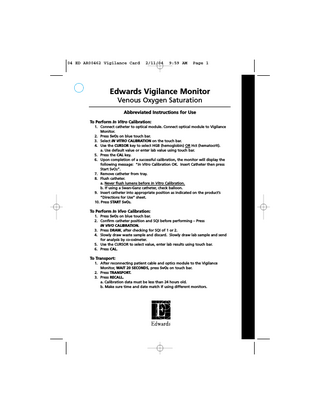Abbreviated Instructions for Use
2 Pages

Preview
Page 1
04 ED AR00462 Vigilance Card
2/11/04
9:59 AM
Page 1
Edwards Vigilance Monitor Venous Oxygen Saturation Abbreviated Instructions for Use To Perform In Vitro Calibration: 1. Connect catheter to optical module. Connect optical module to Vigilance Monitor. 2. Press SvO2 on blue touch bar. 3. Select IN VITRO CALIBRATION on the touch bar. 4. Use the CURSOR key to select HGB (hemoglobin) OR Hct (hematocrit). a. Use default value or enter lab value using touch bar. 5. Press the CAL key. 6. Upon completion of a successful calibration, the monitor will display the following message: “In Vitro Calibration OK. Insert Catheter then press Start SvO2”. 7. Remove catheter from tray. 8. Flush catheter. a. Never flush lumens before In Vitro Calibration. b. If using a Swan-Ganz catheter, check balloon. 9. Insert catheter into appropriate position as indicated on the product’s “Directions for Use” sheet. 10. Press START SvO2.
To Perform In Vivo Calibration: 1. Press SvO2 on blue touch bar. 2. Confirm catheter position and SQI before performing – Press IN VIVO CALIBRATION. 3. Press DRAW, after checking for SQI of 1 or 2. 4. Slowly draw waste sample and discard. Slowly draw lab sample and send for analysis by co-oximeter. 5. Use the CURSOR to select value, enter lab results using touch bar. 6. Press CAL.
To Transport: 1. After reconnecting patient cable and optics module to the Vigilance Monitor, WAIT 20 SECONDS, press SvO2 on touch bar. 2. Press TRANSPORT. 3. Press RECALL. a. Calibration data must be less than 24 hours old. b. Make sure time and date match if using different monitors.
04 ED AR00462 Vigilance Card
2/11/04
9:59 AM
Page 2
SQI for Venous Saturation Monitoring LEVEL
SIGNAL
1
Normal
2
Intermediate
3
Poor
4
Unacceptable
DESCRIPTION All aspects of the signal are optimal Indicates a moderately compromised signal Indicates poor signal quality Indicates severe problem with one or more aspects of signal quality
Signal quality may be compromised by: • Pulsatility. • Signal intensity (e.g., kinking of catheter, blood clot, hemodilution). • Intermittent wall contact by the catheter.
Signal quality may be improved by: • Try to aspirate distal lumen; if able to aspirate, flush lumen with extreme caution. • Check catheter for kinking and recalibrate; replace catheter if required and recalibrate. • Reposition catheter and if SQI > 2, recalibrate monitor by performing in vivo calibration. • Attempt to distance electrocautery equipment and cables from the Vigilance monitor. • Plug the power cords into separate AC circuits if possible. • Update entered hemoglobin and hematocrit values when there is a physiologic change of 6% or greater in hematocrit or of 1.8 g/dL (1.1 mmol/L) or greater in hemoglobin.
Edwards Lifesciences, Edwards and the stylized E logo are trademarks of Edwards Lifesciences Corporation. Swan-Ganz and Vigilance are trademarks of Edwards Lifesciences Corporation and are registered in the U.S. Patent and Trademark Office. © 2004 Edwards Lifesciences LLC All rights reserved. AR00462
Edwards Lifesciences LLC · Irvine, CA 92614 USA · 949.250.2500 · www.edwards.com Edwards Lifesciences (Canada) Inc. · Mississauga, Ontario · Canada · 905.566.4220 Edwards Lifesciences S.A. · Ch. du Glapin 6 · Switzerland · 41.21.823.4300 Edwards Lifesciences Japan · Chiyoda-ku, Tokyo 102-0085 · Japan · 81.3.5213.5700